entire AAA gaming space combinedplayer base is growing by roughly 20% every year
Brands have taken notice, and are now hoping to capitalize on the unique marketing opportunities presented by an interactive metaverse like Roblox. But while modern brands have come to grips with the concept of influencer marketing and streamers, interactive brand activations still feel relatively hard to decipher. Additionally, combining interactive and non-interactive brand strategies in a complementary fashion is rarely talked about, as though each of these advertising avenues exist completely independently from one another.
In this article, we’re examining how Roblox’s massive player base engages with live-streaming platforms, and how the popularity of different Roblox “experiences” (in-platform games) differs between the two avenues. Finally, we look at how combined interactive and non-interactive marketing strategies (via Roblox and live streaming, respectively) may create better brand activations than either avenue alone.
Roblox’s Live-streaming Viewership Reaches New Heights After COVID-Era Spike
Before jumping into marketing strategies, it’s worth reiterating the popularity of Roblox on live streaming to remind brands of its influence. After a massive pandemic-era surge up to 36.2M hours watched per quarter, Roblox viewership had been floating around 25M hours watched. However, off the back of the success of the Dress To Impress experience last year, Roblox viewership hit a new peak quarterly viewership of 57.1M hours watched in Q3 2024. This surge in live-streaming interest coincided with a new peak Daily Active User (DAU) count of 88.1M Roblox players in the same quarter.
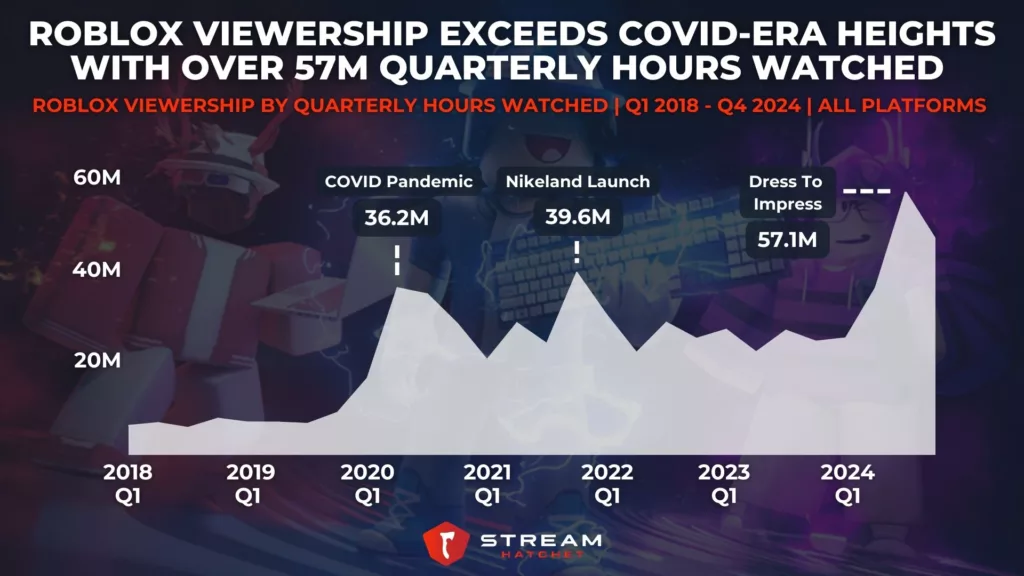
While these viewing numbers are strong, they don’t nearly match up to Roblox’s massive player base. For H2 2024, Roblox was the 27th most watched “game” on live-streaming platforms with 103.9M hours watched. But the top 12 games all hit above 200M hours watched, and even Minecraft, a similarly creative sandbox experience, hit 5th position with 469.2M hours watched.
A couple of factors might explain the disconnect between Roblox’s player base and its live-streaming performance. Firstly, 41% of Roblox users are under the age of 14 while Twitch requires users to be at least 13 years old (hence why most Roblox content is on YouTube). Secondly, Roblox is F2P and is a platform in and of itself. Users may feel that instead of watching streamers engage with experiences, they could simply jump on the platform and start playing. Regardless, players seem to interact with both platforms as seen by the surge in viewership on Twitch when the Nikeland experience launched in November 2021.
Roblox Experience Popularity Doesn’t Correlate with Live-Streaming Performance
In mid-2023, there were an estimated 40M Roblox experiences on the platform with a further 15K experiences being created every single day. Naturally, only a dozen or so of these experiences are popular at any time. However, by looking at the top experiences of all time (as provided by Statista) and their recent popularity on live-streaming platforms, we can gain some insight into how experience popularity translates into viewership.
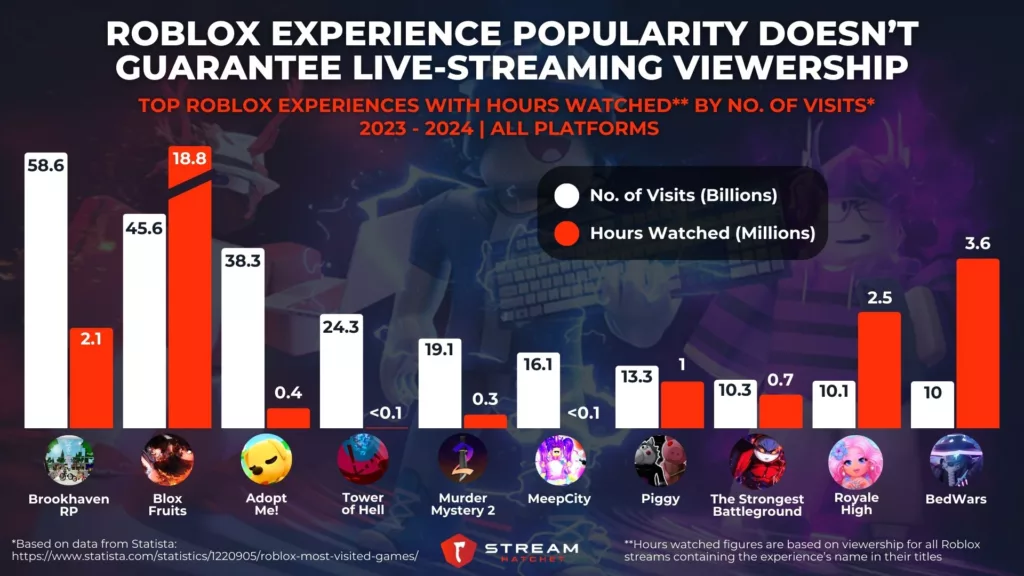
A Roblox experience being popular doesn’t guarantee viewership on live streaming. The most popular Roblox experience of all time is Brookhaven RP with 58.6B visits, yet the experience generated just 2.1M hours watched in the past two years. Conversely, BedWars has almost one-sixth of the all-time visits, yet generated ~175% of Brookhaven RP’s viewership. By far the most watched experience is Blox Fruits, a One Piece-inspired battle simulator with 18.8M hours watched over the past two years.
Instead of looking at all-time visits as a marker of an experience’s popularity on live streaming, a better indicator of success is its social capability. Roblox themselves report that the most popular emerging genre is the so-called “co-opetition” genre in which people create content for one another to use, while simultaneously competing to have the best content. The recent hit Dress To Impress, played by Caseoh_ and Madison Beer among many others, is a perfect example, drawing in viewers with fashion creations that express the creators’ personal style. For this reason, many brands are creating licensing deals with Roblox to capture this social chatter, like the NFL World Football experience which brings American Football to young Roblox players.
Roblox Creates its Own Economy Through Brand Partnerships and Monetization
Given the popularity of fashion experiences on Roblox, it’s no surprise that apparel companies are eager to partner with the platform. Apart from the aforementioned Nike partnership, brands from Gucci to L’Oreal to Supreme all have in-game items for players to purchase with the platform’s currency: Robux. To older readers this might be surprising, but style is incredibly important to Gen Z. In fact, 56% of Gen Z say that styling their digital avatar is more important to them than their IRL style (at least according to Roblox’s own studies on the subject).
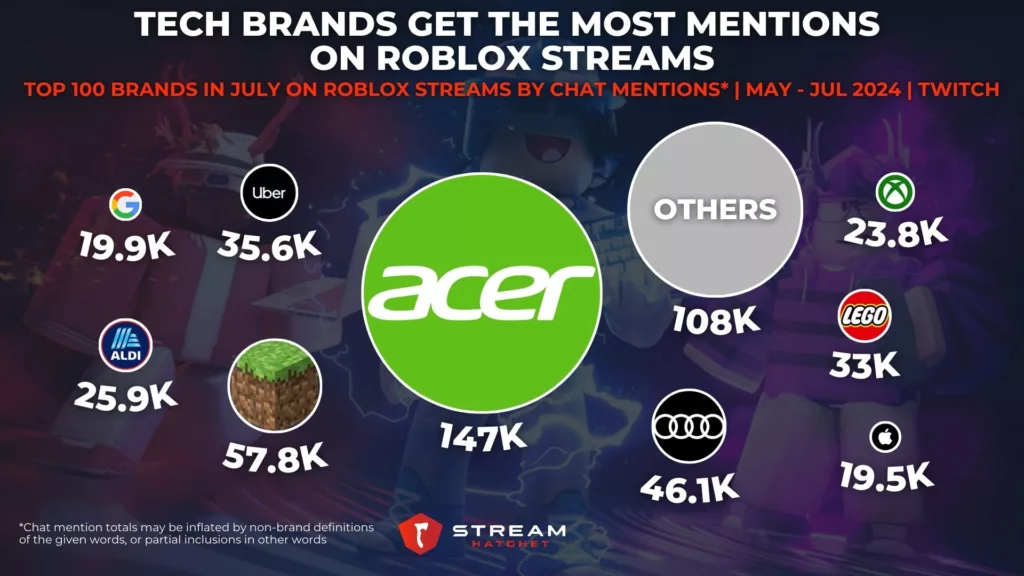
Despite this push from fashion companies, Roblox’s live-streaming audience has a different focus. Looking at a three-month sample of chat mentions on Roblox Twitch streams, tech brands and apps generate the most chatter including Acer with 147K chat mentions and Uber with 36K chat mentions. For users engaged with the metaverse, discussion around tech and services that make virtual life more convenient seems appropriate.
Fashion and tech are just a small slice of advertising on Roblox. Stores like Walmart and Shopify are even enabling purchases of real, deliverable products through the Roblox virtual store. Roblox’s economy is a beast unto itself which is far too complex to fully explore here, but suffice to say that they’ve even implemented a feature similar to Google’s sponsored search function to enable brands to compete with their wallets on the platform.
Why Brands are Getting Into Roblox’s Interactive Marketing
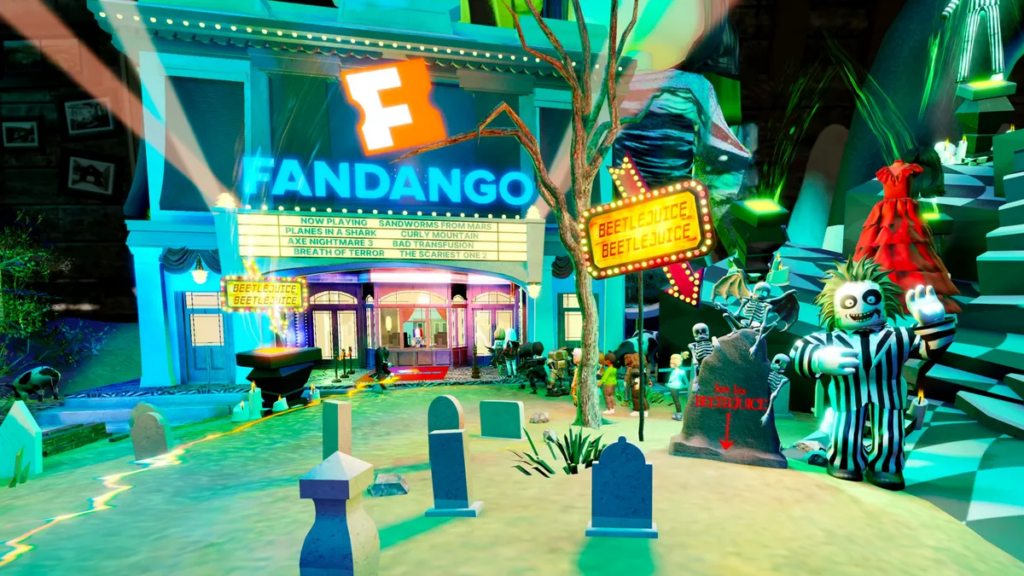
A few months ago, Naavik put out a fantastic podcast exploring some of the ways brands are getting in on Roblox’s popularity. Before we look at how live streaming marketing can synergize with Roblox marketing, it’s worth taking a quick review of the latter’s advantages:
- Roblox is a 3D, interactive platform with metaverse elements. This means it has many of the same advantages as real-life, in situ marketing. For example, seeing someone wearing a branded piece of virtual content might inspire the player to purchase that item for themselves. This is particularly beneficial for apparel and lifestyle brands that have real-life equivalencies like runways, exhibitions, and pop-up shops.
- As an interactive sandbox title, Roblox allows for self-expression and creativity – two qualities highly valued by Gen Z consumers. Brands that allow players to experiment with their iconography increase brand affinity through positive association with play.
- Different experiences nurture highly specific audiences. Brands that understand these unique demographics can create targeted advertising campaigns for their desired consumer base.
Note that brands advertising through Roblox are generally aiming to reach Gen Z consumers. With the average Gen Z individual spending 156 minutes on Roblox every day, advertising through their platform in some fashion is virtually mandatory for any youth-oriented brand. But there are still gaps in Roblox’s marketing possibilities: How can live streaming be used to fill these gaps AND create cross-platform campaigns with greater effectiveness?
Creating Synergy Between Interactive and Non-interactive Marketing
As much as Roblox’s interactive environment provides more cutting-edge opportunities for innovation, live streaming offers many traditional advantages to brands that a game simply can’t guarantee. Given that many current CEOs are Gen X, they may not be comfortable using Roblox as their primary advertising route since they didn’t grow up with advertising in games. As a result, Roblox marketing budgets are often limited to an experimental pool of marketing dollars. Live streaming is therefore a safer alternative for non-experimental brands, creating a bridge between traditional brands and gamers.
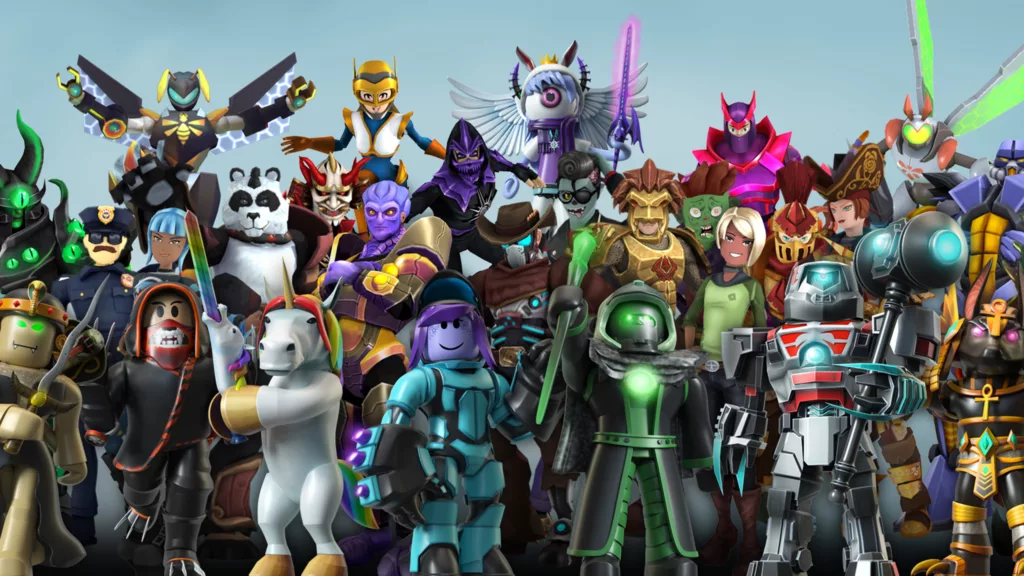
Even for more experimental brands, live streaming offers unique advantages. Roblox developers will often speak about the power of 3D environments in creating natural brand placement opportunities. But these entail the same drawbacks as real-life advertisements: Players can simply ignore an ad or turn away from it. Live streaming, on the other hand, has closer equivalencies with TV advertising: Brand placements occur from a fixed perspective, making them easier to stage and guaranteeing that any viewers who are watching will see it. Additionally, platforms like Twitch are increasingly making integrations that allow viewers to interact with streams themselves – a kind of middle ground between live streaming and interactive environments that preserves fixed perspective.
Live streaming can be used in an additive capacity to Roblox marketing. As noted earlier, a Roblox experience’s popularity doesn’t always translate to live streaming and vice versa. Trying to reach the specific demographic of a certain experience might be easier on live streaming than native advertising through the platform in cases where the experience is highly watched online (e.g. Blox Fruits). Brands could even partner with creators who cover those specific experiences for unique influencer marketing opportunities. Creator demographics shed light on which experiences are worth investing marketing dollars into – discoverable via tools like Stream Hatchet’s own AI Influencer Discovery Program.
Combining live streaming and Roblox marketing is the most sure-fire strategy for reaching a brand’s intended audience. One method can reuse the money invested in creating assets for the other method. For example, a brand creating its own Roblox experience (e.g. Nikeland) can partner with live streamers to get the word out and attract players. As brands become more comfortable with both Roblox and live streaming marketing, exciting new opportunities to innovate in this space with next-generation marketing campaigns will open up.
To stay aware of emerging marketing trends on live-streaming platforms, follow Stream Hatchet:

Comments are closed, but trackbacks and pingbacks are open.